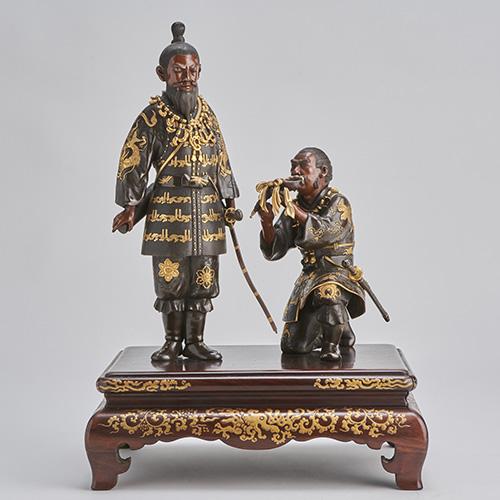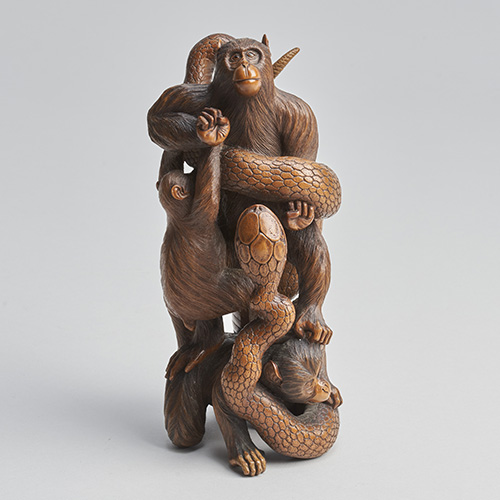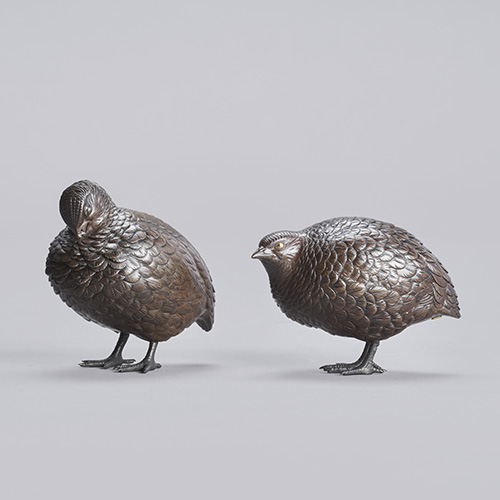

The term Okimono is a Japanese word used to describe an ornament for display or decorative object. It derives from the words ‘oku’ meaning to set, place or assign, and ‘mono’ which means an object or article.
To modern collectors the term Okimono refers to the wonderfully intricate and often highly decorative carvings, sculptures and works of art which began production in Japan from the early years of the Meiji Period (1868-1912).
Larger than netsuke, okimono can be worked in metal, ceramics, and enamel, or carved from ivory or wood. The size and subjects of okimono differ significantly but popular themes include depictions of animals or mythical beasts, gods, characters from folklore, and even scenes of everyday life and people.
They were traditionally placed in a Tokonoma, a type of recessed space, similar to what we in the west would call an alcove. Okimono would often be accompanied in the Tokonoma by other objets d’arts such as a hanging scroll, flower arrangement or bonsai. When entertaining, it is traditional in Japanese culture to seat the most honoured guest beside the Tokonoma.
The reign of Emperor Meiji was a time of profound change for Japan. Sensing the threat of colonization from the West, Japan rapidly transformed from an isolationist feudal system into a powerful industrialised Empire.
 Ironically, two of the sweeping changes introduced would ultimately benefit Japan’s burgeoning art movement. Firstly, the government introduced a national army equipped with modern military weapons to replace the traditional Samurai warriors.
Ironically, two of the sweeping changes introduced would ultimately benefit Japan’s burgeoning art movement. Firstly, the government introduced a national army equipped with modern military weapons to replace the traditional Samurai warriors.
Consequently, the highly skilled metalworkers that for generations had supplied the wealthy Samurai with beautiful, intricately worked swords and armour, turned their attentions to more creative pursuits.
Japanese metalworkers had long used alloys and finishes to create a wide range of colours in Samurai weaponry. Techniques such as Shakudō, an alloy of gold and copper which produces a black finish, or Shibuichi which patinates into shades of blue, green and brown, were a revelation to Western eyes.
The second innovation to positively impact the okimono trade was the popularisation of western clothing among the higher echelons of Japanese society. As gentlemen abandoned the traditional kimono, so in turn there was no longer a demand for netsuke to secure their belongings, meaning many skilled craftsmen turned their workshops over to okimono production.
 Keen to support its artisans, the Meiji government setup the Kiritsu Kosho Kaisha, or First Industrial Manufacturing Company, to promote Japanese art overseas. The Hakurankai Jimukyoku or Exhibition Bureau was also established to ensure that workshops adhered to the highest possible standards.
Keen to support its artisans, the Meiji government setup the Kiritsu Kosho Kaisha, or First Industrial Manufacturing Company, to promote Japanese art overseas. The Hakurankai Jimukyoku or Exhibition Bureau was also established to ensure that workshops adhered to the highest possible standards.
Japan first unveiled its remarkable artistry and craftsmanship to the world at the 1873 World’s Fair in Vienna, receiving universal acclaim. Soon Japanese wares became available in leading galleries and fashionable stores and the fashion known as Japonisme gripped Western collectors.
The exceptional okimono of the Meiji Era remain a testament to a group of artisans at the peak of their creative powers. Regrettably, many of their techniques were lost with the master craftsmen that made them, together with the onset of machine production in the early 20th century. Not surprisingly, more than a century on, okimono remains a highly prized and sought after art form for contemporary collectors.
Click here to view a selection of okimonos currently available from BADA members.

